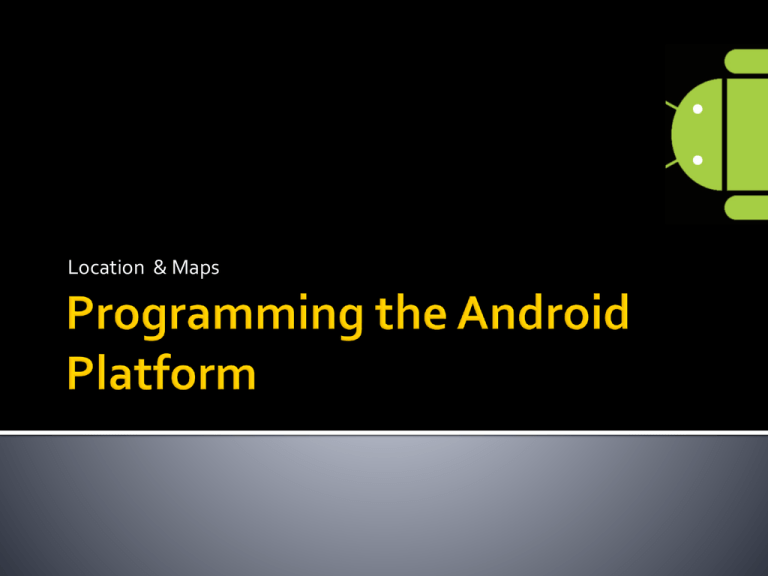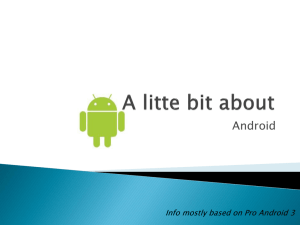Slides_files/LocationAndMaps.pptx
advertisement

Location & Maps
Mobile applications can benefit from being
location-aware, e.g.,
Routing from a current to a desired location
Searching for stores near a current location
Android allows applications to determine &
manipulate location
Represents a position on the Earth
A Location instance consists of:
Latitude, longitude, a UTC timestamp
Optionally, altitude, speed, and bearing
Represent sources of location data
Actual data may come from
GPS satellites
Cell phone towers
Internet
Different LocationProviders will exhibit
different tradeoffs between cost, accuracy,
availability & timeliness
Passive
Returns locations generated by other providers
Requires android.permission.ACCESS_FINE_LOCATION
Network
Determines location based on cell tower and WiFi access
points
Requires either
▪ android.permission.ACCESS_COARSE_LOCATION or
android.permission.ACCESS_FINE_LOCATION
GPS
Determines location using satellites
Requires android.permission.ACCESS_FINE_LOCATION
System service for accessing location data
getSystemService(Context.LOCATION_SERVICE)
Enables
Determining the last known user location
Registering for location updates
Registering to receive Intents when the device
nears a given location
Defines callback methods that are called when
Location or LocationProvider status changes
void onLocationChanged(Location location)
void onProviderDisabled(String provider)
void onProviderEnabled(String provider)
void onStatusChanged(String provider, int status, Bundle extras)
Start listening for updates from location
providers
Maintain a "current best estimate" of location
Stop listening for location updates
Use best location estimate
public class LocationGetLocationActivity extends Activity {
…
public void onCreate(Bundle savedInstanceState) {
…
final LocationManager locationManager = (LocationManager)
getSystemService(Context.LOCATION_SERVICE);
bestReading = locationManager.
getLastKnownLocation(LocationManager.GPS_PROVIDER);
…
locationManager.requestLocationUpdates(
LocationManager.GPS_PROVIDER, 0,0, locationListener);
…
…
final LocationListener locationListener = new LocationListener() {
public synchronized void onLocationChanged(Location location) {
if (location.getAccuracy() < bestReading.getAccuracy()) {
bestReading = location;
tv.setText(getDisplayString(location));
}
…
}
….
Executors.newScheduledThreadPool(1).schedule(
new Runnable() {
public void run() {
locationManager.removeUpdates(locationListener);
}
}, 10000, TimeUnit.MILLISECONDS);
…
Several factors to consider
Measurement time
Accuracy
Provider type
Location measurement drains the battery
Return updates less frequently
Restrict the set of Location Providers
▪ Use least accurate (cheaper) provider possible
Always check last known measurement
A visual representation of area
Today’s examples use Google Maps library
Not part of standard Android distribution
Install SDK add-on
build against add-on ("Google APIs (Google Inc.)"
Permissions
<uses-library
android:name="com.google.android.maps" />
<uses-permission
android:name="android.permission.INTERNET" />
MapActivity
MapView
GeoPoint
Overlay
ItemizedOverlay
Base class for Activities that display
MapViews
Subclass creates MapView in onCreate()
Only one MapActivity is allowed per process
Extends ViewGroup
Displays a Map in one of several modes
Street View - photographs
Satellite View – aerial
Traffic View – real time traffic superimposed
Supports panning and zooming
Support overlay views
Requires a Maps API key
See http://code.google.com/android/add-ons/google-apis/mapkey.html
public class MapsEarthquakeMapActivity extends MapActivity {
public void onCreate(Bundle savedInstanceState) {
super.onCreate(savedInstanceState);
setContentView(R.layout.main);
}
protected boolean isRouteDisplayed() {
return false;
}
}
<RelativeLayout ..">
<com.google.android.maps.MapView
android:id="@+id/mapview"
android:layout_width="fill_parent"
android:layout_height="fill_parent"
android:clickable="true"
android:apiKey=”my Maps API key"
/>
</RelativeLayout>
Represents a location on Earth
latitude and longitude measured in microdegrees
1 microdegree == 1 millionth of a degree
Manages information drawn over a map
E.g., points of interest within a given city
MapView maintains a list of overlays
Retrieve via MapView.getOverlays()
21
Subclass of Overlay
Manages a list of OverlayItems
OverlayItems have a particular location
Draws a drawable at OverlayItem’s location
22
Keeps track of a focused item
public class MapsEarthquakeMapActivity extends MapActivity {
List<Overlay> mapOverlays;
Drawable mOverlayDrawable;
EartQuakeDataOverlay itemizedOverlay;
MapView mapView = null;
public void onCreate(Bundle savedInstanceState) {
…
new HttpGetTask() .execute(
"http://api.geonames.org/earthquakesJSON?north=44.1&south=-9.9&east=22.4&west=55.2&username=demo” );
…
mapView ….
mapView.setBuiltInZoomControls(true);
mapOverlays = mapView.getOverlays();
mOverlayDrawable = this.getResources()
.getDrawable(R.drawable.pushpin_red);
itemizedOverlay = new EartQuakeDataOverlay(mOverlayDrawable);
}
… // called when HttpGet().execute() finishes
private void onFinishGetRequest(List<EarthQuakeRec> result) {
for (EarthQuakeRec rec : result) {
itemizedOverlay.addOverlay(new OverlayItem(rec.getGeoPoint(),
String.valueOf(rec.getMagnitude()), ""));
}
mapOverlays.add(itemizedOverlay);
MapController mc = mapView.getController();
mc.setCenter(new GeoPoint((int) (14.6041667 * 1E6),
(int) (120.9822222 * 1E6)));
}
public class EartQuakeDataOverlay extends
ItemizedOverlay<OverlayItem> {
}
ArrayList<OverlayItem> mOverlays =
new ArrayList<OverlayItem>();
protected EartQuakeDataOverlay(Drawable defaultMarker) {
super(boundCenter(defaultMarker));
}
public void addOverlay(OverlayItem overlay) {
mOverlays.add(overlay);
populate();
}
protected OverlayItem createItem(int i) { return mOverlays.get(i); }
public int size() { return mOverlays.size(); }



